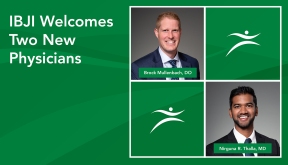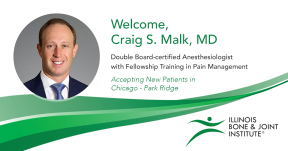Get in-depth answers to frequently asked questions about preventing and treating lifting injuries from a trusted source: IBJI’s Dr. Jing Liang, a board-certified physician in pain medicine, physical medicine, and rehabilitation.

Dr. Jing Liang, MD
Interventional Pain Management and Physical Medicine & Rehabilitation Physician
Dr. Liang sees patients at the IBJI Barrington Doctors’ Office
Q&A with IBJI's Dr. Jing Liang
How Do Lifting Injuries Occur? What Can You Do to Prevent Them?
Dr. Liang: I think lifting injuries occur when we’re in a rush. Whether we’re moving from one household to another or lifting groceries or lifting when we’re working out, we should not rush.
Give yourself time to plan out what you are going to do. It’s crucial because when you don’t think about things—let's say you have a gallon of milk behind you—you might tend to twist and lift. Obviously, that is poor body mechanics, but we don’t think about it because we just want to do it quickly.
For everyday movements, we need to practice good body mechanics.
What Puts Someone at Risk for Hurting Themselves While Lifting Something?
Dr. Liang: When you already have muscles that are recovering from certain activities, they are not going to activate the same way. They are tired from what you’ve done the day before, so the next day, if you’re simply picking up a cracker off the floor, your body has forgotten or gotten a little bit lazy, so that’s when you can suffer lifting injuries.
You need to be aware of your body’s limitations.
Learn about other causes of back pain→
How Can You Avoid Lifting Injuries Caused by Tight Muscles?
Dr. Liang: I’m a big advocate for yoga and stretching. I think that if we were to do any kind of lifting that is repetitive, we really need to be cognizant that we need to warm up our muscles, maybe even with light aerobics.
How Often Do You See Patients with Lifting Injuries in Your Office?
Dr. Liang: If someone has an acute injury, they would normally go to OrthoAccess.
I see patients with chronic pain with recent exacerbations after certain activities. It can be lifting an object or making a bed. People who already have a history of pain and poor biomechanics can sometimes get lifting injuries by picking up a cracker off the floor.
It’s related to somebody changing their body mechanics abruptly and causing pain and injury.
What Are Some Tips to Avoid Lifting Injuries, Particularly During a Move?
Dr. Liang: I think that you have to understand what you’re lifting. If this is moving-related, there are a bunch of things you can do. You have to do your preparation, especially if you’re going to be packing and lifting for hours.
Focus on Good Body Mechanics
Dr. Liang: You don’t want to bend over and lift with just your waist. You want to have your legs to help you. How you carry the object is also very important. If you have a bulky wide object, you want it to be close to your body and above your waist level so you can stand straight and not bend forward while carrying something. The longer you bend over, the more likely you’re going to sprain something or experience lifting injuries.
Use Moving Equipment
Dr. Liang: If you have awkward objects that you’re lifting, use moving equipment. On moving day, there is going to be furniture. You need to use dollies. Also, keep in mind these tips:
- Don’t lift more than 35 pounds.
- Be smart about what you’re lifting.
- Clear paths.
- Wear proper clothing.
Wear a Back Brace
Dr. Liang: If you know you’re going to have a strenuous day and you’re moving for eight hours, it is nice to get some support for your back. Wearing a back brace forces you to flatten your back instead of curving it forward.
It’s okay to wear a back brace, but if you wear it long-term, it actually causes atrophy, the wearing out of muscles in your back, because your body has forgotten how to activate your muscles. You could use it intermittently when you have intense days.
I would not recommend wearing it long-term.
What Is the Most Common Affected Body Part When It Comes to Lifting Injuries?
Dr. Liang: I would say the lower back. I think that when we lift something we tend to bend forward and then we come back. We use our back to go from flexing forward to erecting back. Some of us have poor core or abdominal muscles. We are not used to activating them when we lift. The core is important in helping the back to do its jobs.
Muscle Re-education
Dr. Liang: The more a certain group of muscles is practicing, the more it will work automatically. Opening a doorknob, for example, is something we don’t think about. We reach out an arm and pull towards us. It’s so automatic. This is muscle memory. Muscles remember.
Most of us, we’re not trained to move or twist or lift using our core. That’s why physical therapy and rehabilitation are so important. It puts the ownership on you to learn to do everyday functional things in a different way, activating the muscles in a different way. The more you do that, the more automatic it will become. Your stomach muscles will be helping your back to do these activities.
How Can You Tell if You Have a Lifting Injury?
Dr. Liang: In its mildest case, you will feel stiffness. At its worst, you can be in excruciating pain and you cannot get up.
Find out what are the symptoms of lumbar herniation→
What Are Some At-Home Treatments for Lifting Injuries?
Dr. Liang: You want to rest a little bit. Avoid twisting. You can ice the area 20 minutes on and 20 minutes off.
Some people do respond to heat better because it’s more muscular. Heat goes very well with stretching. You want to stretch after you heat up the muscle. You can do yoga and stretching exercises.
There are at-home TENS (transcutaneous electrical nerve stimulators) that you can use if you have an acute injury. You can take ibuprofen or other anti-inflammatory medications.
I’m a big proponent of anti-inflammatory foods. It’s extremely important to eat right. You really need to keep away from foods that cause inflammatory responses so you can recover faster.
What Specific Foods Do You Recommend?
Dr. Liang: Increasing fiber is a good thing. I would recommend 40 grams of fiber a day. That can come from vegetables, lentils, and beans.
In order to decrease the inflammatory response, you should also increase omega-3 food intake. You can eat fish, pasture-raised animal meat, and eggs. Nuts, flax seeds, and chia seeds are also high in omega 3 and you can make shakes. Cacao and acai are good, too. You can make chocolate muffins with cacao.
Incorporating fiber helps the microbiome in the gut. One of the many reasons that gut health is vital for our overall well-being is by lowering our body’s inflammatory responses.
How Do You Treat Patients With Lifting Injuries?
Dr. Liang: I like to treat them with prescription anti-inflammatory medication. Steroids are very useful. If the patient has nerve pain that comes from a lifting injury, I would use gabapentin, a nerve medication that will calm down the nerve pain that somebody has.
We can do steroid injections in the area if certain muscles or joints are inflamed. We can localize the pain caused by inflammation, and calm it down by injecting steroids and anesthetics in the area.
What I also recommend is to attend rehabilitation to understand body mechanics and promote muscle reeducation to prevent this from happening again.
What Are Warning Signs That You Need Immediate Care?
Dr. Liang: Some alarming things would be that you have very weak legs, you are losing control of your bowel or bladder, or you have a lot of numbness in your leg that was not there before.
Schedule online with an IBJI Physician
Need to see a doctor for pain management? Schedule online today with one of IBJI’s interventional pain management physicians—online or in-person—to learn more treatment options to get you back to feeling your best.
Get Back Pain Relief
If you have experienced a lifting injury, IBJI’s experienced orthopedics team can help.
Explore IBJI’s spine and back pain services



.jpg)
